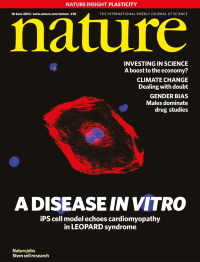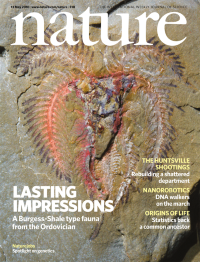Volume 465
-
No. 7301 24 June 2010
The quantum computers and communication networks of the future will require devices that can efficiently store and retrieve the quantum nature of light. Morgan Hedges and colleagues now describe an efficient solid-state quantum memory with light stored by praseodymium ions within a single yttrium orthosilicate crystal. On the cover, a laser beam excites a crystal, which is used as the storage medium in the quantum memory demonstration. Cover credit: Matthew Sellars.
Nature Outlook
-
No. 7300 17 June 2010
Scientists today are accustomed to having their performance assessed by numerical yardsticks, but are 'science metrics' as widely used as those being measured seem to think? In a collection of News Features and an Opinion piece we present the findings of a Nature readers' poll and survey of institutions around the world, examine the plethora of techniques now available, and what exactly they measure, and canvass the opinions of six researchers as to how metrics methodology can be improved. Picture credit: David Parkins.
-
No. 7299 10 June 2010
Patient-specific iPS (induced pluripotent stem) cells have been generated by nuclear reprogramming from patients with LEOPARD syndrome, a rare developmental disorder characterized by skin lesions, heart abnormalities and deafness. Cardiomyocytes derived from these iPS cells have hypertrophic properties resembling those typical of the disease. Using these cell lines it may be possible to identify compounds that reverse diseased cellular phenotypes. The cover depicts a cardiomyocyte derived from a LEOPARD syndrome iPS cell.
Insight
-
No. 7298 3 June 2010
Analysis of over 50 years of data on sockeye salmon returns to the rivers of Bristol Bay, Alaska, shows that the fact that this important commercial fishery is made up of several hundred discrete populations has been a stabilizing factor for overall fish populations. This is a manifestation of the portfolio effect named by analogy with risk-spreading in financial markets and suggests that fisheries management policies should aim to minimize the homogenizing effects of hatcheries on genetic diversity, maintain habitat networks, and protect weak stocks from over-harvesting in mixed stock fisheries. The cover shows adult sockeye salmon spawning in Hidden Creek of the Wood River system of Bristol Bay, August 2008. Photo credit: Michael Webster.
-
No. 7297 27 May 2010
The structures of the membrane domain of respiratory complex I from Escherichia coli, and of the entire complex I from Thermus thermophilus have been determined. Complex I is the first enzyme of the respiratory chain, and the last component of the respiratory chain for which the mechanism and complete structure were unknown. The structures provide strong clues about coupling mechanism: conformational changes at the interface of the two main domains may drive a long α-helix in a piston-like motion, tilting nearby transmembrane helices and resulting in proton translocation. The cover depicts the T. thermophilus respiratory complex I embedded in a lipid bilayer. Picture credit: Rouslan Efremov/Rikke Schmidt Kjaergaard/Leonid Sazanov.
-
No. 7296 20 May 2010
The three-dimensional isosurface rendering on the cover shows Plasmodium falciparum merozoite infection in erythrocytes. Two groups reporting in this issue of Nature have identified several thousand compounds capable of inhibiting the growth of blood-stage P. falciparum parasites, including many distinct in structure and mechanism from current drugs. Details of these compounds are freely available to researchers looking for new antimalarials, urgently needed for the current international efforts to combat the disease. Cover credit: Samuel Connell & Armand Guiguemde, using SlideBook from Intelligent Imaging Innovations (St Jude Children's Research Hospital).
-
No. 7295 13 May 2010
A 'Burgess Shale-type' fauna, rich in fossils of soft-bodied creatures, has been found in the Lower and Upper Fezouata formations of Morocco, dating from about 480-472 million years ago during the Early Ordovician. The Fezouata biota is a link between Burgess Shale communities of the Middle Cambrian and the Great Ordovician Biodiversification Event, previously represented mostly by 'shelly' fossils. The cover shows a marrellomorph arthropod from the Fezouata biota. Cover photo by P. Van Roy.
-
No. 7294 6 May 2010
Alternative splicing allows a single gene to produce more than one protein, and shapes how genetic information controls cellular processes. The Frey and Blencowe labs at the University of Toronto have combined forces to develop a 'splicing code' that predicts how hundreds of RNA features work together to regulate tissue-dependent alternative splicing for thousands of exons (see News page 16). The code has been used to predict how alternative splicing acts in various developmental and neurological processes, and the code has been incorporated into a web tool that allows researchers to scan uncharacterized exon and intron sequences to predict tissue-dependent splicing patterns. Cover graphic by Brendan Frey.








